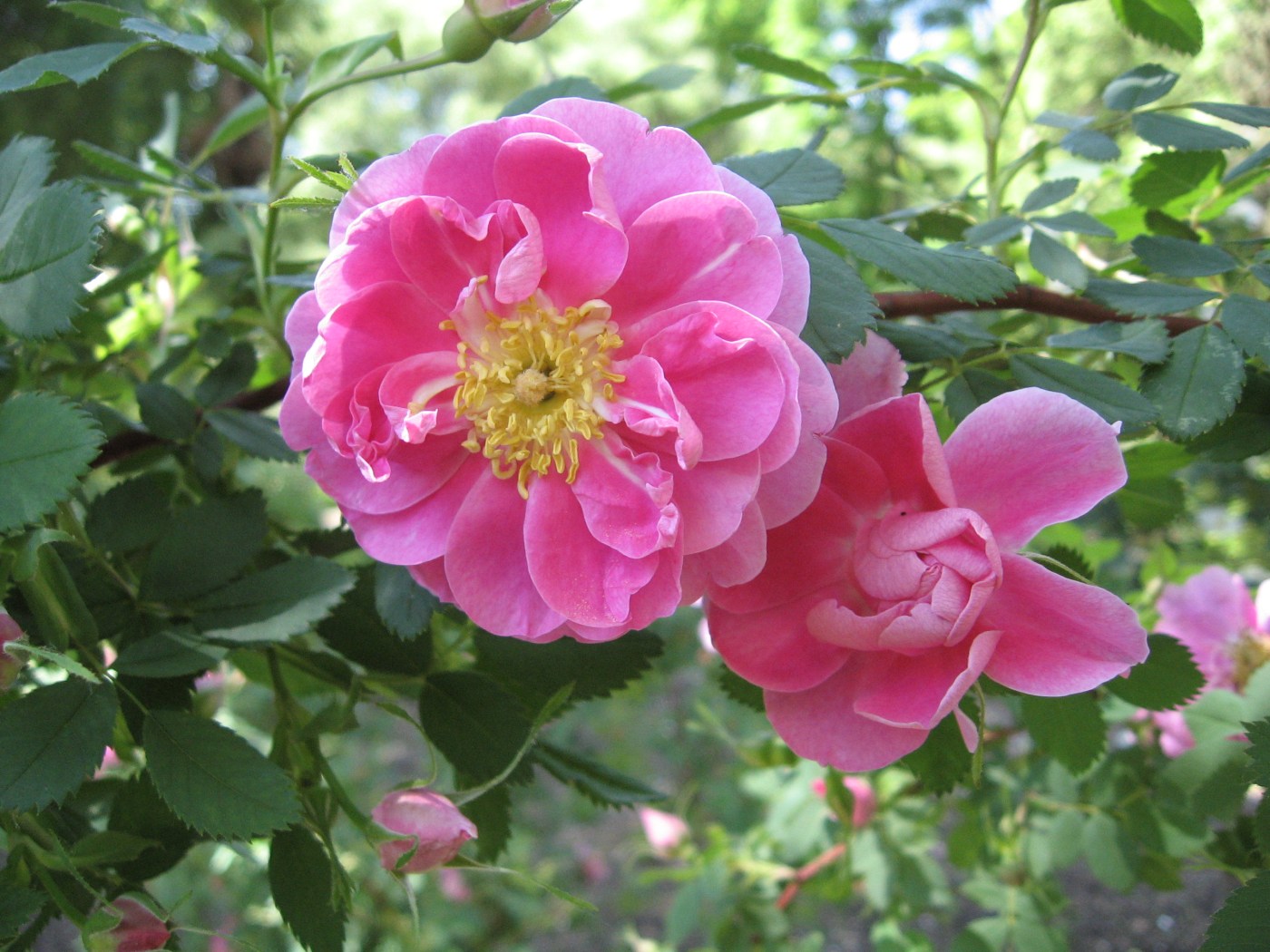Our previous column included notes on pruning and propagating roses, and beginning a project to add roses, by first identifying sites where roses would grow well and then selecting the rose category you want for your garden, with an emphasis on the mature size of various categories. Today’s column reviews the advantages and disadvantages of different kinds of roses. This review applies to all categories of roses. Today’s image gallery Our gallery features examples of various rose types photographed in my garden, as well as two native California species that grow well in the Monterey Bay area, with blossom images from Wikimedia. Bare-root roses vs. container-grown roses In December, nurseries and garden centers typically offer dormant bare-root roses. These are cheaper than potted roses because shipping without soil is less expensive. Another advantage is that the gardener can see if the roots are healthy and well formed. Install these plants promptly, so that their roots do not dry out. Container-grown plants are often available during the growing season. Buyers can review the plant’s foliage, growth habit and sometimes even the flowers. They are usually ready to plant at your convenience and will adapt quickly. The buyer should lift the plant from the pot to see if it’s root-bound. Own-root roses vs. grafted roses Growers develop own-root roses from cuttings, so that the top and the roots are genetically the same. Shrub roses, many old garden roses and modern landscape roses grow predictably on their own roots and are hardier and more shapely than grafted roses. Own-root roses are not vulnerable to the nasty rose mosaic virus, which grafted plants can spread. Own-root roses also do not exhibit rootstock suckering, which can draw down the plant’s resources. Growers always develop hybrid tea roses, floribundas and exhibition varieties by grafting the scion of the desired variety onto a rootstock selected for vigor, adaptability or disease resistance. Gardeners frequently prefer grafted roses, but these roses might be short-lived compared to own-root roses and can develop rootstock suckers. Gardeners should remove the suckers promptly before they overtake the scion. Tear suckers from the rootstock for long-term effect, rather than simply clipping them. Species roses vs. hybrid roses Gardeners can refer to species roses as wild roses. They have attractive, simple flowers, hips and foliage, and are often very hardy, drought-tolerant and resistant to common diseases. Many rose species bloom once each season. Gardeners can easily grow and propagate established species roses. Wildlife favors these roses over hybrid varieties. California native species can become large, rangy shrubs, requiring ample space or vigorous pruning. Our search of Calscape. org yielded nine species of California native roses, plus 10 cultivars of these species. Only two species, wood rose (Rosa gymnocarpa) and California wildrose (Rosa californica) are native to the Monterey Bay area and are available for purchase online. Hybrid roses often bloom repeatedly from late spring through fall, with a wide range of colors, flower forms and fragrances. Gardeners can select from a variety of hybrid roses, including climbers, shrubs, ground covers, miniatures and other forms. Breeders select for disease resistance, compact habit, fragrance, cut-flower quality or other traits. Recent breeding programs focus on resistance to black spot and mildew, or low maintenance. Some hybrid tea roses can be short-lived compared with species or old garden roses, especially when not well-maintained. Advance your gardening knowledge Garden centers and online nurseries feature bare-root roses at this time of the year. Gardeners favor the low prices of these roses and can plant them easily in the garden or in containers. Planting bare-root roses requires a location with at least four hours of direct sunlight each day, and some shelter from strong winds. Soak the roots in water for a couple of hours, dig a hole broader and deeper than the roots, enrich the soil with compost and install the plant so that the graft union is 2 or 3 inches below the soil’s surface. Backfill and water thoroughly. For a step-by-step demonstration of this process, visit gardeningknowhow. com and search for “planting bare root roses.” To purchase the most available California native roses, wood rose (Rosa gymnocarpa) and California wildrose (Rosa californica), visit Calscape and search for the common names of these roses for links to online nurseries. This week in the garden When many plants are dormant and few blooms remain to enjoy, seasonal tasks can keep gardeners active. The management of fallen leaves should include moving them to areas where they can provide nesting and overwintering places for native bees, butterfly larvae and other critical insects. As the leaves decompose, they will add organic matter to the soil. Weeding can be a priority at this season for most gardens. Recent rains stimulated the growth of weed seeds that have been awaiting the fall rains. Weeding can be satisfying, but removing weeds before they go to seed will result in fewer weeds in the future. After clearing a bed of weeds, apply a layer of mulch or a weed barrier to discourage new growth. Now is the time to save seeds from your garden, planting in the spring. The fall season is also the ideal time to install new plants, when seasonal rains will support root growth. Enjoy your garden, especially your roses!.
https://www.santacruzsentinel.com/2025/11/20/tom-karwin-on-gardening-selecting-roses-for-your-garden/
Tom Karwin, On Gardening | Selecting roses for your garden




